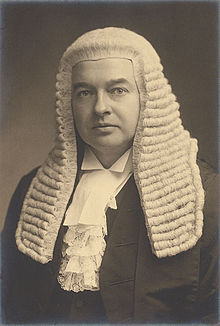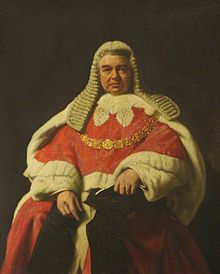| This article includes a list of references, related reading, or external links, but its sources remain unclear because it lacks inline citations. Please help improve this article by introducing more precise citations. (January 2023) (Learn how and when to remove this message) |
| The Right HonourableThe Viscount HewartPC | |
|---|---|
 | |
| Lord Chief Justice of England | |
| In office 8 March 1922 – 12 October 1940 | |
| Monarchs | George V Edward VIII George VI |
| Preceded by | The Lord Trevethin |
| Succeeded by | The Viscount Caldecote |
| Attorney General for England | |
| In office 10 January 1919 – 6 March 1922 | |
| Monarch | George V |
| Prime Minister | David Lloyd George |
| Preceded by | Sir F. E. Smith |
| Succeeded by | Sir Ernest Pollock |
| Solicitor General for England | |
| In office 10 December 1916 – 10 January 1919 | |
| Monarch | George V |
| Prime Minister | David Lloyd George |
| Preceded by | Sir George Cave |
| Succeeded by | Sir Ernest Pollock |
| Personal details | |
| Born | Gordon Hewart 7 January 1870 Bury, Lancashire, England |
| Died | 5 May 1943(1943-05-05) (aged 73) Totteridge, Hertfordshire, England |
| Political party | Liberal |
| Alma mater | University College, Oxford |
| Occupation | Politician, judge |
Gordon Hewart, 1st Viscount Hewart, PC (7 January 1870 – 5 May 1943) was a politician and judge in the United Kingdom.
Background and education
Hewart was born in Bury, Lancashire, the eldest son of Giles Hewart, a draper, and Annie Elizabeth Jones. He was educated at Bury Grammar School, Manchester Grammar School and University College, Oxford.
Political and legal career

Hewart began his career as a journalist for the Manchester Guardian and the Morning Leader. He was called to the bar at the Inner Temple in 1902, joining the Northern Circuit. He took silk in 1912.
He was a Liberal Member of Parliament for Leicester from 1913, and, after the constituency was divided in 1918, Leicester East. An advanced Liberal, he was appointed Solicitor General in 1916, receiving the customary knighthood, and was sworn of the Privy Council in 1918. He was Attorney General from 10 January 1919 to 6 March 1922. He was given a seat in the Cabinet in 1921.
While in office, he refused offers to become Chief Secretary for Ireland or Home Secretary; at the time, the Attorney General had the right of first refusal for the post of Lord Chief Justice, which was Hewart's ambition.
Lord Chief Justice
On the resignation of the Earl of Reading as Lord Chief Justice of England in 1921, Hewart asked to succeed him. However, David Lloyd George was reluctant to lose him, and, as a compromise, the 77-year-old Sir A. T. Lawrence (Lord Trevethin from August 1921) was appointed instead as a stop-gap; he was required to furnish an undated letter of resignation to Lloyd George, an arrangement which scandalised many: Lord Birkenhead thought it 'illegal', while judges boycotted the farewell ceremony for Lord Reading.
On 3 March 1922, Trevethin 'resigned' (an event which he learned from The Times), and Hewart was duly appointed Lord Chief Justice of England on 8 March 1922, and was elevated to the peerage as Baron Hewart, of Bury, in the County of Lancaster on 24 March 1922.
In May 1922 Hewart was closely involved in the drafting of the Constitution of the Irish Free State. He worked closely with his Irish counterpart, Hugh Kennedy in May 1922 to finalise the text in time for elections the following month.

In 1929, Hewart published The New Despotism, in which he asserted that the rule of law in Britain was being undermined by the executive at the expense of the legislature and the courts. This book was very controversial and led to the appointment of a Committee on Ministers' Powers—chaired by the Earl of Donoughmore—but its Report rejected Hewart's arguments.
He has been described as "one of the most vigorous and vociferous believers in the impeccability of the English jury system of this or any other century". However, in 1931, Hewart made legal history, when (sitting with Mr Justice Branson and Mr Justice Hawke) he quashed the conviction for murder of William Herbert Wallace, on the grounds that the conviction could not be supported by the evidence. In other words, the jury was wrong.
Lord Hewart was the originator (paraphrased from the original) of the aphorism "Not only must Justice be done; it must also be seen to be done."
In 1940, Hewart was asked by telephone by 10 Downing Street to resign; he duly did so on 12 October 1940. On his retirement, he was created Viscount Hewart, of Bury in the County Palatine of Lancaster, on 1 November 1940.
Death
He died 5 May 1943 in Totteridge, Barnet, Hertfordshire, aged 73.
Family
Lord Hewart married twice; first in 1892 Sarah Wood Riley, daughter of J. H. Riley and secondly in 1934, Jean Stewart, the daughter of J. R. Stewart. With his first wife he had a daughter Katharine and a son and heir, Hugh. When he died in Totteridge, on 5 May 1943, his titles were inherited by his son, Hugh Hewart, 2nd Viscount Hewart.
Arms
Notable decisions
Notes
- "No. 32653". The London Gazette. 28 March 1922. pp. 2507–2508.
- BRITISH INVOLVEMENT IN THE CREATION OF THE FIRST IRISH CONSTITUTION by Thomas Mohr
- Lord Hewart (1929). The New Despotism. London: Ernest Benn Limited. p. 17. Retrieved 6 November 2024 – via Internet Archive.
- "Lord Hewart's Fear of "New Despotism"". Advertiser (Adelaide, Sa : 1931 – 1954). 14 December 1934. p. 25.
- The Killing of Julia Wallace, by Jonathan Goodman (Headline, London, 1987), p. 251
- "The origins of "Justice must be seen to be done"". barandbench.com. 18 April 2020. Retrieved 21 January 2023.
- "No. 34984". The London Gazette. 1 November 1940. p. 6348.
- Burke's Peerage. 1949.
References
Further reading
- R. Jackson, The chief: the biography of Gordon Hewart, lord chief justice of England, 1922–40 (1959)
- R. F. V. Heuston, Lives of the Lord Chancellors, 1885–1940 (1964)
- R. Stevens, The independence of the judiciary: the view from the lord chancellor's office (1993)
- R. Stevens, 'Hewart, Gordon, first Viscount Hewart (1870–1943)', Oxford Dictionary of National Biography (2004)
External links
- Works by or about Gordon Hewart, 1st Viscount Hewart at the Internet Archive
- Hansard 1803–2005: contributions in Parliament by Gordon Hewart
| Parliament of the United Kingdom | ||
|---|---|---|
| Preceded byEliot Crawshay-Williams and Ramsay MacDonald |
Member of Parliament for Leicester 1913–1918 With: Ramsay MacDonald |
Constituency abolished |
| New constituency | Member of Parliament for Leicester East 1918–1922 |
Succeeded byGeorge Banton |
| Legal offices | ||
| Preceded bySir George Cave | Solicitor General for England and Wales 1916–1919 |
Succeeded bySir Ernest Pollock |
| Preceded bySir F. E. Smith | Attorney General for England and Wales 1919–1922 |
Succeeded bySir Ernest Pollock |
| Preceded byThe Lord Trevethin | Lord Chief Justice of England 1922–1940 |
Succeeded byThe Viscount Caldecote |
| Peerage of the United Kingdom | ||
| New creation | Viscount Hewart 1940–1943 |
Succeeded byHugh Hewart |
| Baron Hewart 1922–1943 | ||
- 1870 births
- 1943 deaths
- Liberal Party (UK) MPs for English constituencies
- Lord chief justices of England and Wales
- Members of the Privy Council of the United Kingdom
- UK MPs 1910–1918
- UK MPs 1918–1922
- UK MPs who were granted peerages
- Attorneys general for England and Wales
- Solicitors general for England and Wales
- People educated at Manchester Grammar School
- Alumni of University College, Oxford
- People from Bury, Greater Manchester
- People educated at Bury Grammar School
- Knights Bachelor
- Members of the Inner Temple
- Members of the Parliament of the United Kingdom for constituencies in Lancashire
- Barons created by George V
- Viscounts created by George VI
